
|
|

|
Table of Contents:
- Greetings from Black Lion Herald
- Greetings from Quentin Dexter Gauntlet
- A Request from Wyewood Pursuivant
- The An Tir Internal Letter of Intent
- LoAR Comments
- February Lion's Blood Meeting Results
- New Submissions
- Return to the IL Archive Page
[Editor's Note: Much of the following appeared in the January 2004 Heralds' Page, however there is some new information and this missive is also to be published in The Crier, so we have printed it here for the An Tir College of Heralds.]
From Black Lion Principal Herald
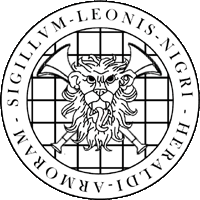
Heraldic Job Openings: To apply send me an email with your mundane and SCA resume to herald@badger.cx and a copy to the current officeholder (email addresses available on the kingdom webpage), or send paper copy to my address from The Crier.
- Lowenmahne, the deputy in charge of Town Crier stuff at crown events, and helping with Field Heraldry and stuff. Talk with current office holder Uilliam for more information. This job will be available at July Coronation.
- Black Stag, deputy in charge of heraldic education in An Tir, and coordinating the An Tir Heraldic Symposium on a yearly basis. This job will be available as of Heraldic Symposium this year in April, but we would like to start training in advance of that.
- Regional heralds!! We are bringing back regional heralds in An Tir! Positions are open for western, rivers, and inlands regional herald positions. The duties of the regional heralds are somewhat TBD at the moment, but I know it will be assisting branches with heraldic needs, collecting reports at reporting times, and fostering heraldry in the region. Please apply now!! People skills a must! These positions will be filled about 1 month after this appears in the Crier, so please let me know as soon as you can if you are interested.
An announcement: Elizabeth Pomegranate has agreed to take on the duties of the Incipient Branch Assistant herald. I'm very happy to have her in this role, as she has tons of experience as both Herald, and Seneschal of the Kingdom and can help a new branch through the somewhat tricky heraldic process for a new branch.
New Incipient Branch Name/Arms registration policy: Accompanying that office, I have made a new policy for An Tir that does not require payment for the first Branch name registration, and the first Branch Arms registration. Please not that this is ONLY for the first instance of the Name and Arms of the branch. It does not apply to name changes, branch badges, order names, etc. etc. This policy is being implemented to help incipient branches meet the requirements for branch status set forth by Kingdom Law. Branches that have already registered names/arms do not qualify for this policy. If you have any questions, please contact me via email and I would be happy to discuss this.

Yours in Service
Frederic Badger
Black Lion Principal Herald
Arms: Sable, a chalice within an orle argent.
Greetings from Quentin Dexter Gauntlet!
It's been a little while since we've talked, but your OP workers have been no less hard at work. There is nothing Kingdom rattling in this update, just a couple of new features to hopefully make the OP better and easier to use.
The first update is that since the OP itself is on web pages, we should use the web's linking and anchor technology. We now do! For each person's alternate name, instead of just telling you what their official name is, we link back to that person's entry. No more backtracking and scrolling through a letter twice! Take a look at http://www.antirheralds.org/awards/OP/roster.html!
Second, in the listing of orders, each of the society wide awards, such as the Peerages for example, now list the Kingdom from which it was received if it wasn't received from An Tir. Confused? Take a look at http://www.antirheralds.org/awards/OP/orders.html and it will be much clearer! Thanks go out to Viscount Sir Jerald of Galloway for this suggestion!
Finally, I'm in the process of recruiting local OP representatives in each branch of the Kingdom. As vast as this job is, it really simply boils down to staying current on the activities of each branch of An Tir. To stay current in say Tir Bannog, I need to know people in Tir Bannog that I can call on to answer OP questions, such as "When did John the Smith really get his AoA?" That person would then call John and find out what we can find out. Of course, our local heralds are prime candidates for this job, but one thing I've learned is that when you have close to 14,000 honors listed in the OP and well over 4,500 people, you just can't get enough eyes looking at the information!
If you're interested in the job, please drop me a line at op@antir.sca.org!
Thank you!
HL Quentin d'Or
Dexter Gauntlet Herald
Kingdom of An Tir
op@antir.sca.org
http://www.antirheralds.org/awards/OP/op.html
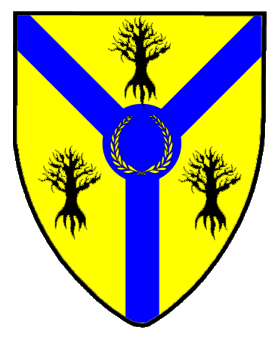
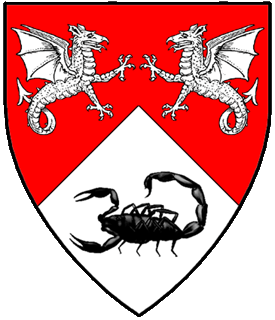 The arms of Earl Edward Cire of Greymoor |
A Request from Wyewood Pursuivant
(Webster's note: the web version of this request has been edited by request of Lady Esclarmonde.)
Greetings Everyone,
As you may know, Wyewood will be holding an event titled "A Celebration of Chivalry" on July 23-25, sponsored by Sir Edward Cire of Greymoor to celebrate the 20th anniversary of his knighting. There will be a LOT of things going on at this event, and as the branch herald I will be responsible for heraldry at this occasion. I am looking for assistance with heraldry for this event.
Below are some of the positions I could use help with:
- Be a "herald" for fighters participating in the Ransom Tournament on Saturday morning. I'm using the quotation marks around "herald" to indicate that in no way does this require you to be an official herald or even have any herald experience. Each fighter in this tournament must have a "herald." The purpose of this "herald" is to represent the fighter. First, the "herald" of each fighter will present him or her to the Royal Patrons at the morning court. During the tournament, the herald shall hold onto the fighter's coins. All the heralds will stay in a safe zone. When a fighter finishes a round of combat, the fighter's herald is responsible for exchanging the ransom coins with the herald of the opponent who your fighter just had combat with. During the tournament itself, these heralds may feel free to engage in cheering and rooting for their fighter.
- Sitting at herald's point/keeping an eye on the Heraldic A&S Display. This is a location where event coordinators can come to say they would like announcement added to the next town cry. It's a really easy job! You can hang out and work on a project while keeping the post manned.
- Town cry. Please consider the other areas of assist before volunteering for town cry. I already have some assistance lined up in this area.
- We are also considering having a consult table at the event. Æstel will be there, so thereİcan easilyİbe a supply of books, but she will be unable to take charge of the table because she is involved at other activities at the event. If there is anyone interested in taking charge of supervising and staffing a consult table, please let me know at LadyEsclarmonde@aol.com.
Thank you for your time!
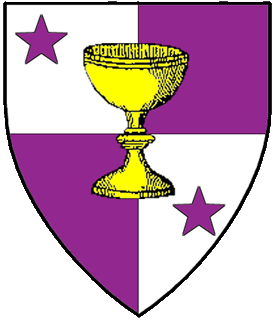
Esclarmonde de Porcairages
Wyewood Pursuivant
LadyEsclarmonde@aol.com
An Tir Internal Letter for March, AS XXXVIII / 2004 CE
| Lady Marya Kargashina lions-blood@antir.sca.org |
March 30, 2004 Send thy comments here: | Jessica Smith-Carlock 5114 SE Holgate Portland, OR 97206 503-772-0002 |
Commentary on this Letter will be due May 14th, 2004.
(Send comments to Lions Blood Herald, information at top of this page)
* * * Change of April Lions Blood meeting venue * * *
The April Lions Blood meeting will be held on Sunday, April 18th, 1pm, at the home of Marya Lions Blood: 5114 SE Holgate Blvd, Portland, OR 97206, (503) 772-0002. Home has small children and a cat.
Directions: From I-5 to Portland take I-205. Exit onto Powell Blvd. and turn toward downtown (west). Follow Powell to SE 52nd Ave and turn left (there's a liquor store on the corner). Down 52nd to Holgate Blvd. (a Plaid Pantry on that corner) and turn right. House is on the left right beside the Plaid Pantry. Park on the street or across the street in the lot beside the Mocha Express and the Learning Center. Do not park in the Plaid lot, they tow. The apartment is #2 on the upper floor.
From the Portland area: Get onto Powell Blvd. and head for SE 52nd Ave. Turn south and proceed to SE Holgate. See directions above for details.
The May Lions Blood meeting will be held on Sunday, May 16th, at the home of Christopher Queue Forchee: 7757 40th Ave. NE, Seattle, WA 98115. The house is in the Wedgwood area, East of Ravenna, North of UW.
Directions:
By Bus: Bus route 71 stops at the end of my driveway, tell the driver you want to get off at 80th St. Bus route 65 stops on NE 80th St & 35th Ave NE, walk 5 blocks east on 80th.
By Car: ** IMPORTANT PARKING NOTE **
The curb in front of my house, and the space directly across the street from it is a bus stop. Don't park there, even though the paint is faded. Easiest parking is on NE 80th St., on the side of the house.
From the South I-5 *Express Lanes*: Take the Lake City Way exit (it's a left-ramp off the freeway). Get into the Right lane of the ramp as soon as possible after exiting the freeway. Turn Right at the first light (NE 80th St). Note: NE 80th does not go through to my house, there's stuff in the way, so... Turn Right at the first 4-way stop (20th Ave NE.). Turn Left at the first light (NE 75th St). Follow the "From NE 75th St" directions, below.
From the South via I-5 (incl. 520 & 90): Take I-5 to exit 171 (522, Bothell). Stay to the right hand of the ramp. Just as the ramp goes around a bend there will be an exit to your Right. Take it. Merge into 73rd heading East (only option). Stop at the stop, stay on 73rd. Turn Left at the next stop sign, onto 12th, heading North again. Turn Right at the light, onto NE 75th St., heading East again. Follow the "From NE 75th St" directions, below.
From the North via I-5: Take the exit for 80th St. & 85th St. Follow the signs for 80th St. East Bound, turning left at the end of the ramp. You will cross over I-5. Continue on 80th St. for a while. Turn Right (south) @ the 4-way stop on 20th Turn Left (east) @ the first light (NE 75th St.). Follow the "From NE 75th St" directions, below.
From NE 75th St: Turn Left at the 4-way stop (onto 40th Ave NE). Go two short "blocks." The house will be on your Left just as the school yard ends, on the corner with NE 80th St. If you completely pass the school yard, or cross over 80th St., you've gone too far.
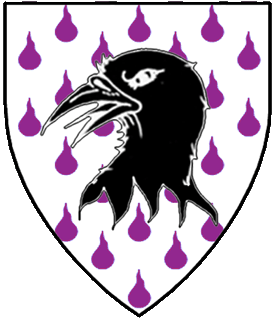
Greetings from Lions Blood.
Unfortunately, I will not be going to Symposium this year. I'll miss being there.
The December LoAR has no results from An Tir. This resulted from a submission packet late to Laurel because of Lions Blood office turnover confusion. The results from the An Tir June IL/August LoI will be on the January LoAR. Nothing has been lost, it has simply been delayed.
Marya
Last month we brought you all the An Tir results from the October and November LoARs. This month we bring you Words of Wisdom from the Sovereigns of Arms as printed in the October, November, and December cover letters. Some of this information is pertinent to submissions on this month's IL, so read with care.
From the Cover Letter to the October 2003 LoAR:
From Laurel: New Precedents Available
The precedents of Elsbeth Anne Roth, Laurel, and Pietari Pentinpoika Uv, Pelican, have been completed. They are available on-line on the Laurel precedents Web page, http://www.sca.org/heraldry/laurel/precedents.html, and are available in print for $7.00 through Free Trumpet Press West / SCA Marketplace.
The precedents of our tenure are available in an ongoing draft form on the Web, and may be accessed through a link on the aforementioned Laurel Web page. The latest update information for these draft precedents is given at the top of each of the subpages for armory and name precedents. (The names and armory precedents may not be updated at the same time, so check each subpage individually).
From Wreath: Suns and Moons
There have been a number of requests in the commentary to modify the gender used in referring to (for example) a sun in its splendor or a moon in her plenitude. We allow suns to be either masculine or neuter, and we allow moons to be either feminine or neuter, and we will retain the submitter's blazon when feasible.
From Wreath: Generic Birds
In the last months we have often received commentary suggesting that some charge should be reblazoned from a specific sort of bird to a generic bird (e.g., reblazoning a hawk as a bird). We remind the College that we should only reblazon a specific sort of bird as a generic bird when the specific bird truly cannot be identified as such. We also remind the College that the reblazon to a generic bird has unfortunate side effects for conflict. As noted on the LoAR of April 1998, "Blazoned on the LoI as [a specific type of bird], as drawn it is not clearly any species of bird, so we have reblazoned it as a generic bird. Unfortunately, generic birds conflict with all birds, so this conflicts with ..." When one proposes to reblazon an imperfectly-drawn "hawk" as a generic "bird", it would lose an often-critical type CD from past or future submissions using swans, herons, chickens, peacocks, ostriches, hummingbirds, penguins, and so forth. Never forget that the suggestion to reblazon a specific bird as a generic bird is also a proposal to reward a poor artist with an unwontedly huge slice of armorial space. When we reflect on the quality of much period heraldic artwork, which is rarely precise in its depiction of birds or other animals, I think we can all agree that birds should only be reblazoned as "generic" birds when there is no other alternative.
We have also continued to receive commentary indicating that ravens that are not drawn as "hairy" birds should be reblazoned as generic birds. This suggestion does not match period armorial style, which often depicts ravens as smooth-feathered birds. Please refer to the cover letter to the January 2002 LoAR, which discusses this matter in detail, including citations in commonly-available heraldry books showing specific examples of smooth-feathered/non-hairy corbies in period heraldic art.
From Wreath: Augmentations
This was a busy month for augmentations. An augmentation is one of the highest honors bestowed by the SCA: it behooves us to make policies for augmentations as clear as possible, so that the excellent people receiving the honor have as little difficulty with registering augmentations as possible. Therefore, while the ensuing discussion mostly addresses issues raised by the augmentations this month, it also addresses some other general issues and policies that arise frequently when considering augmentations.
We particularly direct kingdom heralds to the sections on "Kingdom Badges that are Designated as an Augmentation" and "Augmentations and Appropriate Content", as they set forth some previously unstated policies and interpretations.
Who Specifies the Form of an Augmentation
We remind the College that the form of an augmentation is determined according to the normal registration process: the submitter proposes the form of the augmentation and it is either accepted (or not) based on the Rules for Submission. The form of the augmentation cannot be mandated by the crown bestowing it. RfS VIII.7 states "While the right to an augmentation is bestowed by the crown, its form is subject to the normal registration process." The Board of Directors has upheld this policy:
[Concerning an augmentation whose form was specified by the granting Crown] At the time of the August [1987 Laurel] meeting this submission was pended, despite the strong conviction of most of the College that it infringed on the proper usage of [a reserved charge]. Since it involved a "constitutional issue", i.e., in the event of conflict between the will of the Crown and the decision of the College, which takes priority. As the Board of Directors at its January meeting has now decided that the College may not be compelled to register that which is in violation of its existing rules, this submission is now formally returned. (LoAR February 1988)
Augmentations and General Paperwork
If a person's device changes at the same time that an augmentation is added, the armorial changes need to be performed in two separate submissions actions, each with its own set of submission forms: one for the change of the device (without the augmentation) and one depicting the changed device and adding the augmentation: "... as we protect both the augmented arms and the unaugmented arms, a device change and an augmentation must be submitted as two separate actions" (LoAR October 2000).
Augmentations and General Conflict Issues
RfS VIII.7 states, "If [the augmentation] has the appearance of being independent armory, for example a charged escutcheon or canton, then it is independently subject to the normal rules of armorial conflict." This means that the augmentation must be checked for conflict as if it were a separate piece of armory.
Note that the converse is not true: it is not necessary to check new devices or badges for conflict against previously existing augmentations that have the appearance of being independent armory. This is because the augmentations do not have an existence separate from the arms that they augment, and therefore are not independently protectable entities. Per the LoAR of October 1985: "Arms may be borne with or without an augmentation, but the augmentation should not be used separately from the arms."
Some commenters have theorized that if a person registers an augmentation that appears to be independent armory, the independent armory is somehow grandfathered to the kingdom that originally bestowed the augmentation, and thus (the theory continues) the independent armory could be registered by any new recipient of an augmentation from that kingdom. But this cannot be the case, because the augmentation does not have an independent existence, and because the kingdom has no ownership of, or even control of, the form taken by an individual's augmentation.
Note also that, per RfS VIII.7, it is not necessary to check augmentations for conflict when they do not have the appearance of an independent display of armory. If someone's augmentation takes the form ... and for augmentation, in chief a rose argent, the rose in chief does not have the appearance of an independent display of armory, and one does not have to check it for conflict as if it were (Fieldless) A rose argent.
We also remind the College that augmented arms are to be checked for conflict both with and without the augmentation: "Augmentations in Society armory should always be blazoned as such; the bearer has the option of displaying the armory with or without the augmentation, and conflict should be checked against both versions" (LoAR September 1992, pg. 26).
Augmentations and Letters of Permission
The SCA has previously registered augmentations that appeared to be independent armory and were in conflict with - or identical to - a badge owned by a kingdom or some other entity. In these cases, it has been necessary for the person with the augmentation to have a letter of permission from the owner of the badge in order to register that augmentation. As noted in the LoAR of September 1995 regarding an augmentation (which was in conflict with armory belonging to a kingdom):
For the ... conflict, we need to receive a letter of permission to conflict signed by the Crown or the kingdom Seneschal. It has always been the policy of the College not to assume that permission is given even if explicitly stated in a LoI (which was not the case here), but to require a copy of a written letter of permission to conflict.
Such permission was explicitly stated to be present in the first of a (relatively) long line of augmentations from the crown of Caid where the recipient elected to use the Caidan War Banner on a charged canton or escutcheon, per the LoAR of October 1995: "A letter of permission from the Crown of Caid for the use of the War Banner of Caid as an augmentation has been received by the Laurel office." These letters of permission to conflict have not always been mentioned in the LoAR, but are present with the paperwork.
Kingdom Badges That Are Designated as an Augmentation
In the case where a kingdom has a badge designated as an augmentation, it seems appropriate to rule that a person or entity with an augmentation from that kingdom may be assumed to have permission for his/her/its augmentation to conflict with the specifically-designated augmentation badge. Kingdoms that already have badges that are serving as an augmentation should strongly consider adding the "augmentation" designation to those badges, to cut down on subsequent paperwork with letters of permission to conflict.
A kingdom badge that is designated as an augmentation may not imply any particular rank or status for the bearer. It is appropriate for a kingdom to consider adding an "augmentation" designation to a populace badge, ensign, war banner, or a previously undesignated badge without reserved charges. It is not appropriate to add an "augmentation" designation to an order, award, or office badge, or to an undesignated badge with a reserved charge.
The augmentation of the Kingdom of Meridies, (Fieldless) Three mullets one and two argent, was registered in the LoAR of March 1996 with the following comments: "This is an augmentation of arms which the Crown of Meridies may grant to individuals it deems worthy. It's [sic] purpose is not the same as a fieldless badge; as an augmentation, it should always be displayed on a field by the recipients." These LoAR comments referred to the fact that the armory contained charges that were not conjoined. Then, as now, such armory was illegal style on a fieldless badge per RfS VIII.5. But, because an augmentation will always be displayed on a field, a designated augmentation may break these fieldless style rules. The other constraints in RfS VIII.5 could also be broken for an augmentation, so a kingdom could register an augmentation of (Fieldless) a bordure embattled ... or (Fieldless) a bend charged with ..., even though these would not be registerable designs for any other type of fieldless armory.
It also seems appropriate to allow a kingdom's designated augmentations to incorporate armorial motifs that are grandfathered to that kingdom, thereby allowing users of a designated augmentation to receive the same grandfathering that the kingdom would have. As an example, hypothesize that the Kingdom of Atlantia chose to designate its badge, (Fieldless) A unicornate natural seahorse erect azure, finned argent, as an augmentation. The SCA's current policies do not allow new registrations of unicornate natural seahorses without the use of the grandfather clause. A hypothetical Atlantian recipient of an augmentation could place the designated augmentation on any suitable place on his device. If he already had an uncharged canton Or on his device, he could create the augmentation for augmentation, on the canton a unicornate natural seahorse erect azure, finned argent. However, a hypothetical Atlantian recipient of an augmentation could not use the designated badge to create the augmentation for augmentation, on a canton Or a unicornate natural seahorse erect azure finned argent. This augmentation would not be identical to the designated augmentation, and thus, the kingdom's grandfathering would not extend to this augmentation.
Augmentations and Appropriate Content
The September 1995 LoAR ruled in general that no piece of armory could be exactly duplicated as an augmentation: "We have not previously allowed armory, even as an augmentation, to be an identical version of the armory of a group or office, whether or not a letter of permission to conflict existed." However, this portion of ruling has been overruled by the October 1995 acceptance of the Caidan War Banner as an augmentation, and by successive similar registrations. At this point, in some cases augmentations may be identical to armory belonging to a group (or an individual). However, the point that an augmentation must not appear to be a claim to "status or powers the submitter does not possess" (RfS XI) is one that must be considered whenever an augmentation is registered.
Precedent notes that, in at least some cases, the use of a badge of office as part of an augmentation may give an incorrect implication that the holder of the augmentation is the holder of the office. Since that statement will not always be true, the augmentation is not allowed in that circumstance. The LoAR of September 1995 dealt with an augmentation where the owner of the augmentation quartered her original coat with a quartering that was a tinctured version of a kingdom herald's seal. That ruling read, in the immediately pertinent part:
The exact conflict with the seal of the office of the ... Principal Herald is more troublesome for a couple of reasons... [one reason that] it is troublesome is that it was a period practice for the holders of an office to marshal the arms of the office with their personal arms. This does not appear to apply to former holders of the office, but only to incumbents. As a consequence, this augmentation appears to be a claim to be the current ... Principal Herald, which does then fall afoul of our rules against the claim to 'status or powers the submitter does not possess' (RfS XI).
We also believe that any augmentation that incorporates the badge of an office in a fashion that resembles an independent display of arms is likely to give a very strong implication that the submitter holds that office, even outside of the context of marshalling. We note that there is no pattern of use of badges of office used in the SCA as augmentations. Only one such augmentation has been registered (a sinister canton of the arms of the Exchequer of the West registered in 1979). Therefore, we rule that it is not permissible for an augmentation to exactly duplicate a badge of office, even with a letter of permission.
Precedent holds that individuals may not register an augmentation that uses an inappropriate reserved charge, as it would be such a claim to "status or powers the submitter does not possess". Per the LoAR of April 1992: "Laurel wreaths have always been reserved in the Society to branches of the Society, and may not be registered to an individual. (see, e.g., Baldwin of Erebor, LoAR of 10 March 1985, p.4) It is Laurel's belief, and that of many of the commenting heralds, that this restriction applies to augmentations as well as to devices, the same way that coronets and loops of chain, even as augmentations, have been restricted to those who may rightfully bear them."
It also seems appropriate to consider whether an augmentation may ever duplicate the badge of an order or award. Such an augmentation gives a strong implication that the owner of the augmentation is a member of that order, or a holder of that award. We at this time rule that such an augmentation cannot be registered if the owner of the augmentation is not a member of that order or does not hold that award, even if he has a letter of permission from the branch that owns the badge. We leave open the question of whether it is ever appropriate to register an augmentation that is identical to an award or order badge.
From the Cover Letter to the November 2003 LoAR:
From Laurel: Got Bids for KWHS 2005?
It's time to put in bids for Known World Heraldic Symposium in 2005. Please provide your bids to the entire College of Arms. Please have your bids to the College by May 1, 2004, so that commentary may be received and a decision may be announced at KWHS 2004. The Laurel Web site contains a useful article on bidding and running a Known World Heraldic Symposium: http://www.sca.org/heraldry/laurel/kwhsart.html.
From Wreath: Badgers and Brocks
This month, some questions were raised about the tincture of a previously registered SCA brock proper. The tincture of a brock (or badger) proper is not clearly defined in SCA or real-world heraldic practice. We here state explicitly that the SCA has no default proper tincture for brocks or badgers. In this LoAR, we have reblazoned the few pieces of existing SCA armory that were blazoned using brocks or badgers proper.
From Wreath: Birds and Substantial Difference
This month we were called upon to make a number of rulings concerning difference between very different types of birds. After much thought, and discussion with Evan Wreath-designate, we have formulated the following policy.
Policies concerning birds and substantial difference need to be built upon previous policies concerning birds and significant difference. An important ruling on the topic is found in the Cover Letter for the January 2000 LoAR. That ruling was entitled On Owls and Eagles, but it also spoke more generally concerning difference for birds. The pertinent summary portions of that ruling read as follows:
The conflict rules make a rigid distinction between the type of a charge and its posture. This works well most of the time, but less so for birds, where the type and the posture are often closely connected. In particular, with vanishingly rare exceptions the eagle is the only bird found displayed in period heraldry. Therefore any other bird displayed will arguably be visually similar to an eagle...
The new solution to the problem is to sacrifice some of the theoretical purity of separation of type and posture. Because only eagles among birds are attested as displayed in period, any other bird in a displayed posture will be compared to any bird in a displayed posture usuing [sic] the visual test of rule X.4.e for non-period charges. Thus there will not be a CD between an owl displayed and an eagle displayed, because they are too visually similar, but there will be a CD between an owl displayed and a penguin displayed, because there is still significant visual difference. Additionally any bird other than an eagle in a displayed posture will be considered a "weirdness" [step from standard period practice].
In the future I expect that I will be more likely to grant difference between different types of birds when (a) [sic] they are (a) different in period, (b) in a period posture, (c) drawn correctly, and (d) there is some visual difference (i.e., there is really no visual difference between a popinjay and a hawk).
In some cases, it is appropriate for very different types of bird to be given substantial difference from each other. This parallels the SCA's precedents for other kinds of similarly-formed, but nonetheless very different, animate charges: bulls and lions were ruled substantially different in the LoAR of July 2001, dragons and griffins were ruled substantially different in the same LoAR, zebras and stags were ruled substantially different in the LoAR of May 2001, unicorns and wolves were ruled substantially different in the LoAR of March 1994, and ferrets and hedgehogs were ruled substantially different in the LoAR of September 1991.
In order for two birds to be considered substantially different from each other, it is necessary for the following conditions to apply, analogous to the criteria listed in the January 2000 Cover Letter for significant difference between birds:
- The change from one type of bird to the other type of bird must "not usually [have been] used to indicate any form of cadency" in period (RfS X.2). The two types of bird must of course also have been considered different in period, or they would not even be significantly different (RfS X.4.e).
- Each bird, in both the new and the old submissions, must be in a posture which was period for that type of bird.
- Each bird, in both the new and the old submissions, must be drawn correctly.
- The two types of bird must have been drawn in fashions that were consistently very different from each other throughout period heraldry.
Concerning criterion 2, remember that a bird may be in a period posture without being in a default posture. Ravens are sometimes found in the rising posture in period, although their default posture is close. Swans are found in the close posture in period, although their default posture is rousant (synonymous with rising).
It is vanishingly rare to find birds other than eagles in the displayed posture, while vast multitudes of eagles are found in the displayed posture. We thus re-affirm the January 2000 Cover Letter precedent (above). All birds (other than eagles) in the displayed posture are considered a "weirdness" and are not eligible for substantial difference - unless documentation is provided showing that the particular type of (non-eagle) bird is frequently found in the displayed posture in period.
Here are a few generalizations concerning bird posture to be used in conjunction with criterion 2 above. In addition, see the attachment to this LoAR titled "Some birds and the postures in which they are found in period English heraldry."
- Barring evidence to the contrary for a particular type of bird, it may be assumed that any type of bird is in a period posture when it is close.
- If a bird is found in a rising posture in period, it is reasonable to assume that both rising wings addorsed and rising wings displayed are standard variants of that posture.
- Period birds that are reguardant are considered a standard posture variant of period birds that are not reguardant. So, if a bird is found in the rising posture in period, it is reasonable to assume that rising reguardant is also a period posture. One cannot make the same assumption about guardant.
- Turning any type of bird to sinister is considered a standard posture variant for all period heraldic postures, due to long-standing SCA practice. So, if a bird is found in the naiant posture in period, then for purposes of SCA heraldic rulings we will also consider the naiant to sinister posture to be period.
On examining the types of birds found in period armory, and how they were used, certain categories of bird type become apparent. These categories are:
- Swan-shaped birds, including swans, geese, and ducks: waterfowl with long necks, rounded bills, long heavy bodies, webbed feet.
- Crane-shaped birds, including cranes, herons, and storks: tall thin birds with long necks, long pointed beaks, medium-weight bodies, very long legs.
- Poultry-shaped birds, including chickens, quail, partridge, and peacocks: compact rounded birds with short to medium necks, short beaks, heavy rounded bodies, medium or short legs, often with distinctive tails or head details (combs, crests).
- "Regular-shaped" birds, including martlets, ravens and other corbies, raptors (hawks, eagles, and owls), and doves: birds with the classic "bird shape". Compact light- or medium-weight birds with small necks and beaks, short to medium legs, plain tails.
Not all period birds are found in the categories above. For example, while many popinjays (parrots) are drawn as "regular-shaped" birds in period (often indistinct from a green crow with red legs and bill), some of the more naturalistic drawings of popinjays have such pronounced tails that popinjays, for the moment, been left out of any of these categories.
Substantial difference relates to these categories of birds as follows:
- Birds within a category are not substantially different from each other. They may be (but are not always) significantly different from each other based on the criteria in RfS X.4.e. Within the "regular-shaped birds" category, there is significant difference between an owl (close guardant) and a dove (close), but not substantial difference. However, in the same category, there is no difference between a falcon rising and an eagle rising.
- Birds in different categories are given substantial difference from each other as long as they meet the general requirements for substantial difference listed above. Thus, a correctly drawn dunghill cock (close), in the "poultry-shaped" bird category, is substantially different from a "crane-shaped" heron (close), a "swan-shaped" swan close, or a "regular-shaped" martlet (close). However, a "poultry-shaped" dunghill cock volant is not substantially different from a "regular-shaped" dove volant, because, while the dove is found in the volant posture in period heraldry, the dunghill cock is not.
- Birds that are not mentioned as part of the categories above must have their eligibility for substantial difference determined on a case by case basis. In particular, SCA-compatible birds that are not found in period heraldry, such as some New World birds, may be considered in a category with very similar Old World birds, on a case by case basis.
Society Pages
Evan da Collaureo, incoming Wreath King of Arms, will be made a Companion of the Order of the Pelican on February 21.
From the Cover Letter to the December 2003 LoAR:
From Laurel: RfS X.4.j.ii
After due consideration and with the thoughtful advice of the College of Arms, we are amending the Rules for Submission section X.4.j.ii. This change is limited to X.4.j.ii and does not modify X.4.j.i. Thus, it only redefines the cases in which substantially changing the type of a group of charges on charges can give a clear difference. The main purpose of this rules change is to simplify this rule and make it easier to apply.
We are redefinining "simple case" to match the current phrasing of X.2: "has no more than two types of charge directly on the field and has no overall charges". In addition, we are removing the term "simple" from X.4.j.ii, because it has been confusing to use the term "simple" in two parts of the armory conflict rules (RfS X.2 and RfS X.4.j.ii). There is one additional change: X.4.j.ii no longer requires the the group of charges on a charge to be composed of identical charges. But it does continue to require that the type of the entire group of charges on a charge be changed to grant a CD under this rule.
RFS X.4.j.ii is changed to read:
ii. For armory that has no more than two types of charge directly on the field and has no overall charges, substantially changing the type of all of a group of charges placed entirely on an ordinary or other suitable charge is one clear difference. Only the new submission is required to meet these conditions in order to benefit from this clause. A charge is suitable for the purposes of this rule if (a) it is simple enough in outline to be voided, and (b) it is correctly drawn with an interior substantial enough to display easily recognizable charges.
Sable, on a pale argent three lozenges sable has one clear difference from Sable, on a pale argent three ravens sable. Or, on a heart vert a pheon argent has one clear difference from Or, on a heart vert a cross moline argent. Argent, on a fess azure between two pine trees vert a spear argent has one clear difference from Argent, on a fess azure between two pine trees vert a rose argent. Or, on a chevron between two millrinds and a lion passant gardant sable three escallops argent does not have a clear difference from Or, on a chevron between two millrinds and a lion passant gardant sable three crosses crosslet argent because there are more than two types of charges directly on the field. Gules, a lion rampant, overall a bend argent semy-de-lis sable does not have a clear difference from Gules, a lion rampant, overall a bend argent billetty sable because there is an overall charge. Gules, on a pale Or a crescent between two fleurs-de-lis gules has a clear difference from Gules, on a pale Or three mullets gules. However, it does not have a clear difference from Gules, on a pale Or three crescents gules, because the type of all of the tertiary charges has not been changed.
Argent, a lion rampant gules charged with a cross crosslet Or does not have a clear difference from Argent, a lion rampant gules charged with a heart Or because the lion is too complex in outline to be voided. Gules, on a mullet of six points Or a cross crosslet sable does not have a clear difference from Gules, on a mullet of six points Or a pellet because the interior of a correctly drawn mullet of six points is too small.
As a new submission, Argent, a lion rampant and on a chief gules three fleurs-de-lis argent does not conflict with Argent, a lion rampant between three mullets and on a chief gules three crosses crosslet argent, even though the latter does not meet the conditions of this rule. The new armory has only two types of charges directly on the field, so there is one clear difference for substantially changing the type of the tertiary charges; the second is for removing the mullets (see RfS X.4.b). If, however, the second armory were new and the first already registered, the second armory would conflict with the first; as there are more than two types of charges directly on the field, there would be just one clear difference for adding the mullets.
We were pleased to see the discussion and research that was given to this question and commend all who participated. Special thanks to Siren for coordinating the discussions on this rule change.
From Laurel: Devices for Consorts and Royal Heirs
This month we were called upon to reflect on the SCA's policy of registering devices for a consort (either for a kingdom or a princpality), or for royal heirs apparent (also for a kingdom or principality). We have no evidence of a real-world consort having arms that differed from her husband's (except for marshalling). We likewise have no evidence of an heir apparent having arms that were not a differenced version of the arms of their parent, except for marshalling, and for fiefs that the heir apparent might have had (such as the Dauphiné, ruled by the dauphin, the heir to the French throne).
The practice of registering devices for the consort and heirs is falling out of favor in the SCA in general. Some of the newer kingdoms have not registered devices for their consorts and their heirs. We applaud the trend to a more period practice with regards to arms, or lack of separate armory for the consort and heirs.
Because the SCA device is parallel to real-world practices for arms, the SCA shall no longer register devices for consorts or for heirs to a kingdom or principality after July 2004.
Under this decision, consorts in kingdoms or principalities without consort's arms may use the undifferenced kingdom arms, and kingdoms may elect to allow both heirs to the throne to display the kingdom arms differenced by a label or other standard mark of cadency. This matches some period armorial display for royal arms.
Kingdoms and principalites that currently have arms registered for the consort or heirs may submit changes to the registered armory via the application of the grandfather clause. We shall require a poll of the populace showing support for changes to the armory. Note that this poll has not previously been explicitly required for the armory of the heirs apparent, but it seems appropriate to require such a poll, which is already required for consorts.
Kingdoms and principalities that currently have arms registered for the consort or heirs are encouraged to consider following period practice and to discontinue the use of the armory.
From Laurel: Help Wanted for the Heraldic Packet Service
The Heraldic Packet Service (alias SquidPak) provides copying and distribution of heraldic correspondence to various realms in the Known World. Its primary focus is on providing inexpensive mailing to realms outside the USA (Drachenwald, Ealdormere, Lochac). Currently, Æthelmearc, Ansteorra, Atlantia, Drachenwald, Ealdormere, Lochac, and the Outlands make use of the service. The Heraldic Packet Service is a private service that is not directly associated with the College of Arms or any realm's College of Heralds.
Dave Montuori is seeking volunteer(s) to take over at least the production side of the "SquidPak" heraldic packet service, so that Dave's SCA persona may devote more time to armory decisions over the next three years. The successful candidate need not be a herald, though some familiarity with the College of Arms submissions process is a plus; training in that aspect of the job will be provided if needed.
The primary attribute being looked for is the temperament suitable for the position of Kingdom Chronicler, as this job is remarkably similar to that of the editor of a kingdom newsletter. The requirements of the job are:
- to collect contributions to the packet from heralds in the various member realms (almost every contribution is sent electronically);
- print out masters of electronic contributions;
- make the requisite number of copies of each contribution;
- label and stamp envelopes for each member of the CoA Mailing List;
- stuff each envelope with one copy of each packet contribution, then seal and mail the envelopes. (Hand delivery is acceptable for local deliveries or on special occasions such as KWHS.)
Errors in copying, collating, or stuffing are Frowned Upon, and you must be able to get the packet out every month without fail (and not on the last day of the month if at all possible). You may also be responsible for keeping track of costs for each contributing realm, and sending out periodic invoices for reimbursement.
Interested parties should contact Dave, whose contact information is in the Roster; please send all e-mail inquiries about this job to squidpak@scadian.net to ensure that your ee-mail does not get lost in the spam-stack.
Society Pages
Mistress Shauna of Carrick Point, Laurel-designate, was made a baroness of the court of Artemisia at Estrella War on February 14.
RESULTS OF THE FEBRUARY LIONS BLOOD MEETING:
The February meeting was held at the home of Aedan Mountains and attended by Marya Lions Blood, Ciaran Goutte de Sang, Meadhbha Dragon's Mist, Teceangl Ounce, Laurence of Damascus and Elsa Haakonsdotter.
The following names and armory have been sent to Laurel (February LoI) --
| Ceolflæd Pyper, change from Gwynhavyr of Heather Glen | Name, and Device, Change |
|---|---|
| Per pale azure and vert, a dragon passant to sinister regardant within an orle of mascles argent | |
| Ceolflæd Pyper | Badge, New |
| (Fieldless) A leaf within and conjoined to a mascle argent | |
| Donnchad ua Catháin | Name and Device, New |
| Sable, a fess checky Or and gules between two mullets argent. | |
| Fionnghuala inghean mhic Oitir | Name, New |
| Submitted as Fionnghuala nic Oitir, and lacking evidence for the use of the element nic in period, we have changed the article in accordance with Sharon Krossa's Quick and Easy Gaelic Names, which states, "Similarly, <nic> is a contraction of <inghean mhic>; although in the 16th century <inghean mhic> was pronounced like modern <nic> (roughly \neek\) in some dialects, the spelling <nic> did not come to be used in Gaelic until later." | |
| Giuliana Audaci | Device, Resubmission |
| Pily bendy wavy sable and argent, on a chief Or three crescents sable. | |
| Rowan Keele | Device, New |
| Checky sable and Or, a fox sejant contourny within a bordure gules. We note Malcolm Og MacDonald - June of 1994 (via An Tir): Or fretty sable, a wolf sejant guardant gules with the dexter forearm of a human raised proper all within a bordure gules, and find it clear by X.1. Elsbeth precedent: [Azure fretty Or, a sword proper vs Azure fretty Or, a hare salient argent] The fret is the primary charge here, so the only change is the type of the secondary. (Calontir, Kingdom of, 10/96 p. 10) |
|
| Stromgard, Barony of | Badge, New |
| (Fieldless) A sea urchin contourny argent.
Should both pass, this badge is to be associated with the award name Silver Sea Urchin, Order of the, which was submitted on the An Tir LoI of 25 November 2003. |
|
| Telia Theagenous | Name and Device, New |
| Argent, a pitcher bendwise azure within a bordure compony azure and Or.
Submitted as Telia, Daughter of Theagenes we have changed the byname in accordance with the submitter's request for authenticity, thanks to very helpful research by the College commenters. |
|
| Valgard Forkbeard | Device, New |
| Per pale vert and azure, two stags heads cabossed argent and in base a drakkar argent | |
| Zachary le Bigod | Name, New |
| Submitted as Zacharias Le Bigod, we have changed the given name to be temporally consistent with the byname, and used the documented uncapitalized article. | |
The following were returned for further work:
| Fionnghuala inghean mhic Oitir | Device |
|---|---|
| Per saltire purpure and azure, a saltire Or.
This was returned for conflict with Jamaica - September of 1995 (via Laurel): Per saltire vert and sable, a saltire Or. There is only one CD for changes to the field (X.4.a.). |
|
| Sayna of Lincoln | Device |
| Gules, on a pale azure fimbriated argent a brunette melusine proper tailed argent There are several style problems with this device: the size of the lines on the fimbriation cause it to appear as double fimbriation on both the line drawing and colored versions; also the melusine is not the conventional argent proper, but a distinct Crayola marker orange. Both are reason for return on their own. Additionally, this device is in conflict with Gisela Fiona of Warwickshire - May of 1992 (via the West): Or, scaly vert, on a pale azure a mermaid proper, tailed Or. There's a CD by X.4.a.ii. for changing the field (scaly is a field treatment and considered an aspect of tincture, so "Or, scaly vert" is a tincture same as "ermine" or "vair" is). However, the only thing that's changed about the tertiary charge is that it's half Or. Same type, number, and mermaids default to affronty so same orientation. No CDs can be generated from the tertiary charge groups, and this is a conflict. |
|
| Sayna of Lincoln | Badge |
| (Fieldless) A brunette Caucasian mermaid proper tailed argent.
This device is in conflict with: Colin of Duntamknackan - August of 1979: (Tinctureless) A merman, bow in dexter and arrow in sinister hand, tail raised to sinister. X.4.a.iii. says that tinctureless and fieldless are the same thing, so that gives us the fieldless CD, but if something is tinctureless a change other than adding tincture is needed for another CD (X.4.d.). No difference for gender is given in heraldry. Morgan Alanna Morcheartaigh - February of 1989 (via Trimaris): Per fess azure and sable, a auburn-haired mermaid proper, tailed argent, maintaining in her dexter hand a plate and in her sinister a sword bendwise sinister proper. One CD for fieldlessness, but no others. |
|
| Zachary le Bigod | Device |
| Or, a phoenix purpure rising from flames gules.
This device is in conflict with: Rüdeger Günther Marenholtz - November of 1993 (via the Outlands): (Fieldless) A phoenix purpure nimbed Or, rising from flames proper. There is a CD for fielded versus fieldless (X.4.a.iii.) but nothing for the nimbus and nothing for changing half the tincture of half the charge for a net gain of 25% tincture change (flames proper to flames gules). |
|
| Zachary le Bigod | Badge |
| (Fieldless) A phoenix purpure rising from flames gules.
The badge is also in conflict with: Rüdeger Günther Marenholtz - November of 1993 (via the Outlands): (Fieldless) A phoenix purpure nimbed Or, rising from flames proper. There is a CD for fieldlessness but nothing for the nimbus and nothing for changing half the tincture of half the charge for a net gain of 25% tincture change (flames proper to flames gules). |
|
NEW SUBMISSIONS:
| 1. Amice de Châtillon | Stromgard | Name and Device, New |
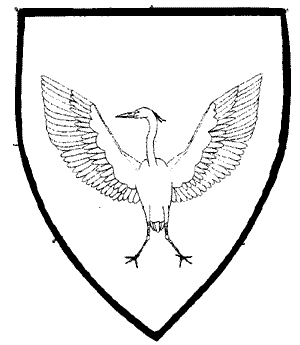 |
Purpure, a heron displayed argent The submitter accepts minor changes, cares most about sound, and desires a feminine name. She will accept a holding name. Amice is cited from E. G. Withycombe's Oxford Dictionary of English Christian Names, sub Amice, "this name very popular from the 12th to 15th C..." Chatillon is cited from Dauzat, Dictionarie etymologique des noms de famille et prenoms de France,sub Chatillon. |
|
| 2. Angus Argyll of Clyde | Three Mountains | Name and Device, New |
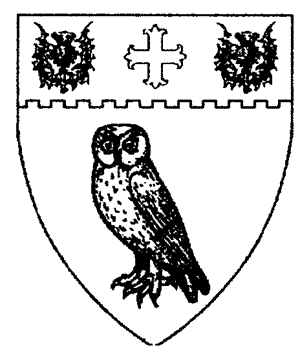 |
Gules, an owl, and on a chief embattled argent a cross flory gules between two thistles proper. The submitter accepts any changes, and desires a masculine Scottish name. He will accept a holding name. Angus is cited from George F. Black, The Surnames of Scotland, sub Angus: Angus son of Somerled, c.1150; Angus mac Dunec..c. 1204-1211. Argyll is cited from George F. Black, The Surnames of Scotland, sub Campbell, "Sir Duncan Campbell...created Lord Campbell in 1445, was the first of the family who took the designation of Argyll..." Clyde is cited from George F. Black, The Surnames of Scotland, sub Clyde: Villelmus Clide 1493; William Clyde 1580; Helen Clyde 1665. |
|
| 3. Annys Bradwarden | Montengarde | Device, Resubmission to Kingdom |
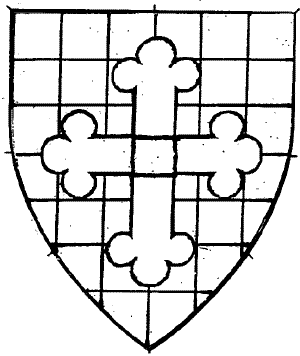 |
Checky argent and azure, a cross bottony sable quarter-pierced argent. The submitter's name was registered in August of 2003. Her previous device, Checky argent and azure, a cross bottony sable, was returned from kingdom in April of 2003 for conflict with Aengus Stiubhard Mac Dhughaill - January of 1996 (via Calontir): Barry and per pale argent and vert, a cross crosslet fitchy sable. Bottony is an artistic variant of crosslet, and crosses fitchy received no difference from non-fitchy crosses in period, so the crosses are heraldically identical, leaving only one CD for the field. |
|
| 4. Caitrina inghean Anndrais | Lions Gate | Badge, New |
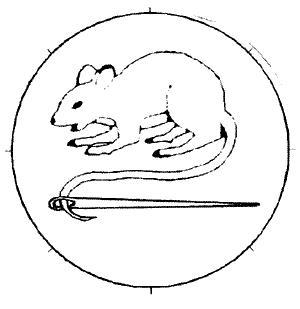 |
In pale a mouse statant argent tail threading a needle fesswise reversed sable. The submitter's name appears on the February 2004 IL. She will accept a holding name. The badge is intended to be fieldless. |
|
| 5. Catherine Townson | Seagirt | Name and Device, New |
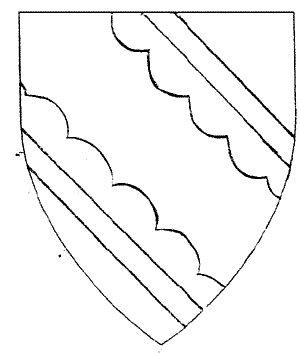 |
Argent a bend engrailed sable cotised plain azure. The submitter accepts minor changes and desires a 16th century English feminine name. She will accept a holding name. Catherine is cited from Reaney & Wilson, A Dictionary of English Surnames, sub Townson: "Catherine Toinson, Towenson 1591". Townson is cited from Reaney & Wilson, A Dictionary of English Surnames, sub Townson: "'Edmund Tollenson, Townson 1571 La Wills; Robert Tolneson, Townson 1580 ib.". |
|
| 6. Cerridwen of Conwy | Lionsdale | Name and Device, Resubmission |
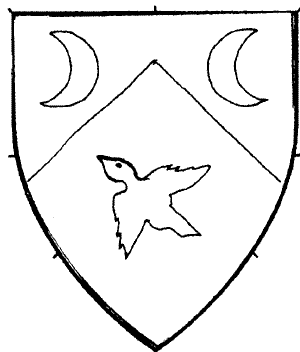 |
Per chevron, azure and or incresent and decresent moons, a raven sable rising volant. The submitter desires a female name, accepts any changes, requests a female name with no other preferences, and will not allow a holding name. Her previous name submission, Cerridwen yr Iachawr, was returned from kingdom in June 2003 for lack of documentation for the byname. Her submitted device, Per chevron azure and Or, two increscents Or and a raven rising contourny sable, was found to be a conflict with Daniel of Rutland, registered in August of 1992 (via Atlantia): Per chevron azure and Or, two increscents Or and a bird volant bendwise holding in its beak an artist's brush sable. Cerridwen was affirmed SCA compatible in this spelling on the LoAR of November 2000. Conwy is cited from a website describing Conwy Castle, which states, "Built between 1283 and 1287 by King Edward I..." the URL is http://www.hotels-wales.co.uk/northwales/conwycastle.htm and a copy of the first page only has been included. The College is asked to please assist with the documentation. This lady deserves a registration. The field is per chevron azure and Or, the increscent and decrescent are Or, and the raven is sable. |
|
| 7. Cragmere, Shire of | c/o branch seneschal | Badge, New |
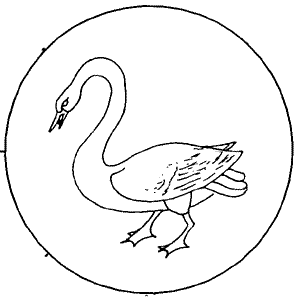 |
(Fieldless) A swan close gules beaked and membered sable. The Branch name was registered in July of 1997. The form is signed by the seneschal. |
|
| 8. Dragos cel Rau | Glymm Mere | Name and Device, New |
 |
Sable, two wolves combattant and a sun argent eclipsed sable. The submitter accepts any changes, cares most about language/culture (unspecified) and desires a masculine name. He will accept a holding name. Dragos is cited from Sara L. Friedmann, "Names from the Royal Lines of Moldavia and Wallachia", http://www.ellipsis.cx/~liana/names/romanian.html, and dated to c.1351-1353. cel Rau is cited from the same website, glossed as meaning 'evil, uneasiness, misfortune', and dated to 1508-1509, 1592, 1592-1593. Copies of this webpage have been included. The sun is Or, its center sable. Both wolves are argent. |
|
| 9. Dragos cel Rau | Glymm Mere | Badge, New |
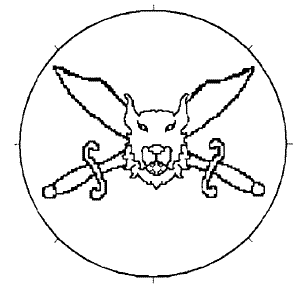 |
(Fieldless) Two scimitars crossed in saltire argent, overall a wolf's head cabossed sable. His name appears above. |
|
| 10. Edelinne de Bayonne | Stromgard | Name and Device, New |
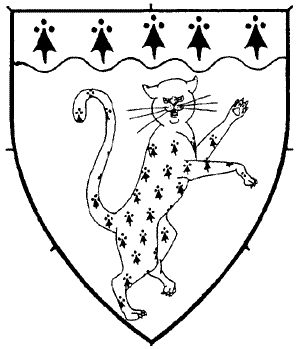 |
Vert, a catamount rampant gardant contourny and a chief wavy ermine. The submitter accepts all changes and desires a 1300-1500 authentic French feminine name. She will not allow a holding name. Edelinne is cited from "An Index to the Given Names in the 1292 Census of Paris" by Colm Dubh and online at http://www.sca.org/Heraldry/laurel/names/Paris.html. Bayonne is cited from Dauzat, Dictionaire Etymologique des noms de France, sub Bayon. The article de is said to be French for "of". |
|
| 11. Elizabeth Dougall | Eisenmarche | Device, Resubmission |
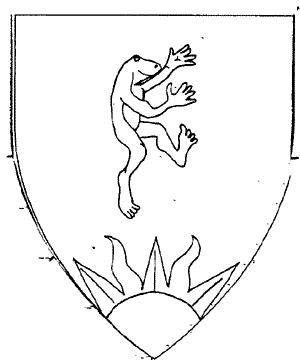 |
Azure, a frog rampant sinister and issuant from base, a rising sun Or. The submitter's name was registered in July 1998. Her previous device submission, Azure, a frog rampant to sinister Or and issuant from base a demi sun Or, was returned from kingdom in December of 2001 for unidentifiability of the frog. This is a redraw. |
|
| 12. Emer Ó Tighearniagh 'Atha An Rí | Wyewood | Name and Device, Change change from Giacinta da Venezia |
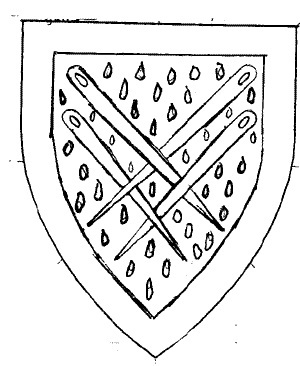 |
Argent, goutty gules, four needles purpure points in base, saltaire and fretty, within bordure gules. The submitter accepts all changes, cares most about language/culture, and desires a 600-1200 Irish feminine name. Her current name, Giacinta da Venezia, and device, Per saltire vert and ermine, on a lozenge Or a rose barbed and seeded proper, were registered in August of 1994. She wishes to release her name and retain her device as a badge. Emer is cited from Peter Beresford Ellis, A Dictionary of Irish Mythology, pg 100 as the wife of Cu Chulain. The Online Onomasticum Godelicum at http://minerva.ucc.ie.6336/dynaweb/locus/dictionary/@Generic_BookTextView/43233 contains the text, "Emer's Half and by the sea-shore..." Ó is cited from the Oxford English Dictionary as an Irish word meaning 'descendant' and used as a prefix of patronymic bynames. Tighearniagh is cited from the Online Onomasticum Godelicum, http://minerva.ucc.ie.6336/dynaweb/locus/dictionary/@Generic_BookTextView/36042: "908: al. Clann Domhnaill mic Lairein, a sub-branch of Cenel Tighearnaigh." Átha An Ri is cited from the Encyclopaedia Brittanica, sub Athenry, ' Irish Baile Atha An Ri (Town of the King's Ford), market town, County Galway, Ireland. It was founded in the 13th century during the Anglo-Norman Colonization.' Only the exact entries from each website were included, no full website texts. The help of the College is requested with this name. |
|
| 13. Francesca Maria Volpelli | Terra Pomaria | Name, New |
|
The submitter accepts all changes, cares most about sound, and desires an authentic 15th-16th C Northern Italian feminine name. Francesca is cited from De Felice, Nomi, sub Francesco. Maria is cited from De Felice, Nomi, sub Maria. Volpelli is cited from De Felice, Cognomi, sub Volpe. |
||
| 14. Jehanne de Nîmes | Blatha An Oir | Name and Device, New |
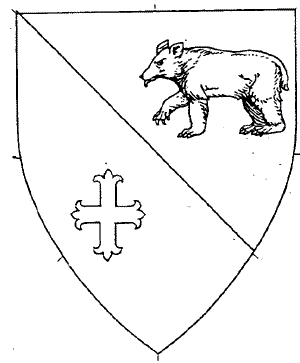 |
Per bend argent and vert, a brown bear passant proper and a cross fleury argent. The submitter accepts minor changes and desires an authentic 13th C French feminine name. She will accept a holding name. Jehanne is cited from "An Index to the Given Names in the 1292 Census of Paris" by Lord Colm Dubh at http://www.sca.org/heraldry/laurel/names/paris.html which shows Jehanne la Normande. It is also seen in "Given Names from Brittany, 1384-1600", by Heather Rose Jones at http://www.s-gabriel.org/names/tangwystyl/latebretom/, where this spelling (sub Johann(a/es)) is given as the feminine form and dated between 1478 and 1561 in 36 occurrences. Nimes is cited from the city's website, http://www.ot-nimes.fr/english/histoire.html, which gives a founding date of between 31 BC and 1AD, with much activity in the medieval period. Copies of all sources are included. |
|
| 15. Maura Cethin | Adiantum | Name and Device, New |
 |
Argent, a bend cotised vert, between two natural panthers courant contourny sable. The submitter will accept any changes, and desires a feminine name authentic for "English/Welsh". She also wishes to retain the sound. She will accept a holding name. Maura is cited from the appeal of the return of the name Maura McLeod, which was in turn registered in September of 2001. The appeal cited the following information: Butlers Lives of the Saints (the full four-volume set), which identifies four saints named "Maura." Most notable among them is Maura of Troyes, who is said to have died on September 21, 850 (September 21 -pp.610-il). Other Mauras mentioned in Butlers include: Saint Maura, possibly born in Northumbria in the 5th century (July 13 - pp.88-89), Saint Maura, of whom little is known except that she was a virgin saint and that a cult to her was active in the time of the Emperor Julian (July 23 - p.171), and Maura, wife of Timothy, both of whom were martyred circa 286 (May 3 - pp.223-224).2. The Catholic Online website also recognizes Maura of Troyes, and indicates that the life of Saint Maura was documented by Saint Prudentius of Troves, who is said to have known her. http://www.catholiconline.org/saints/saints/mauratroyes.html. The name Maura is also found in Scotland, in a town called Kilmaurs, in Ayrshire, where there is a church commemorated to a Saint Maura, who is said to have died in 899. Her feast day is celebrated in November. The name of the village derives from the Gaelic "cil," and Maura, the Saint for whom it is named. It should be noted that one source spells her name as "Maure" and one spells it as "Maura." The church at Kilmaurs is described as "ancient" and is mentioned in public records as early as 1174. Sources:
Chalmers, George. Caledonia: or, an Account, Historical and Topographic of North Britain, from the MostAncient to the Present Time (three volumes). London: A & R Spottiswoode, 1824. The LoAR of September 2001 has a lengthy discussion on the sources given, and includes the following paragraph: Dauzat and Rostaing (p. 636 s.n. Ste-Maure) date S. Maura as a form of this placename in 1136. Therefore, at least one saint (probably the saint known as Maura of Troyes, d. 850) was certainly known by this name in France in the 12th C. As such, the name Maura may be registered in the context of a 12th C French name. The submitter may wish to know that the similar-sounding name Mora, a Latinized form of the Gaelic feminine name Mór is dated to 1541 in Scotland. Cethin is cited from Morgan and Morgan sub Cethin Pg 69. No other information is given. |
|
| 16. Muirgheal inghean Labhrain | Cragmere | Device, Change |
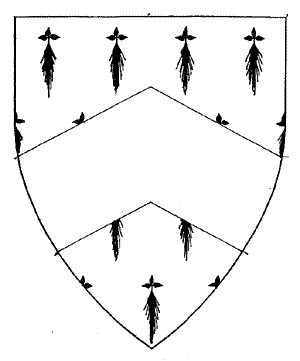 |
Ermine, a chevron azure. The submitter's name was registered in November of 2000. The submitter wishes to retain her current device, Argent, a bear's jambe erased, in chief three blackberries sable hulled vert, registered in November of 2000, as a badge. |
|
| 17. Nadezhda Volynskaiia | Coeur du Val | Name and Device, New |
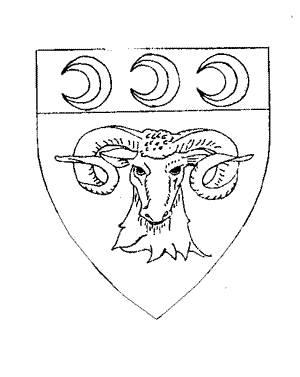 |
Vert a ram's head caboshed argent, and in a chief argent three increscents sable. The submitter will not accept major changes, cares most about meaning and language/culture. She wants the name to mean "hope", and "girl from Volyn". She desires a feminine Russian name. She will accept a holding name. The submitter relied exclusively on Paul Goldschmidt's Dictionary of Russian Names 2nd ed found online at http://www.sca.org/heraldry/paul/index.html and even included copies. Nadezhda is the header spelling, given the meaning of 'hope', and dated 1238. Volynskaiia was formed from the name of the city Volyn. Goldschmidt lists Volyn as having been founded in the 9th century, which is within the submitter's general timeframe. The submitter cites discussion on toponyms: "adjectival forms include: D'iak Ivanovitch Rzevskii ("of Rzev") and Fedor Starodubskii ("of Starodub") thus -skii". From the section on surnames: "Surnames must agree with the gender of the subject, therefore all women's surnames ended in '-a' or '-ia'". The submitter has thus added an "a" for sound aesthetics, and because it works better in Cyrillic. |
|
| 18. Rauþúlfr inn Orþstóri | Wyewood | Device, Resubmission |
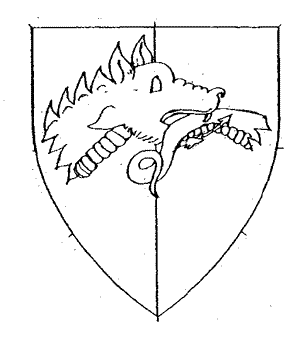 |
Per pale purpure and vert a dragon's head contourny erased maintaining in its mouth a dragon's tail erased unverted Or. The submitter's name was registered August 2000, and his previous device submission was returned from kingdom in 1992. The submitter includes a letter from Helena of Birka granting permission to conflict with her registered armory, Per saltire azure & gules a dragon's head couped contourny Or. The submitter's blazon indeed does say "unverted", as does his Letter of Permission to Conflict. |
|
| 19. Serena Alessandra della Luna | Porte de l'Eau | Device, New |
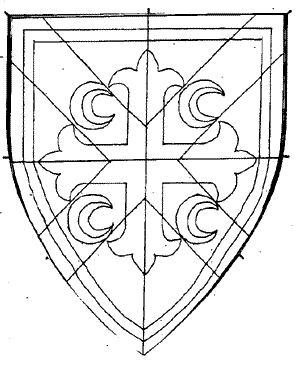 |
Quarterly Or and azure, a cross fleury, four decrescents on a saltire within a tressure all counterchanged. The submitter's name was registered in October of 2003. |
|
| 20. Sybil de Bossinney | Cáe Mór | Name and Device, New |
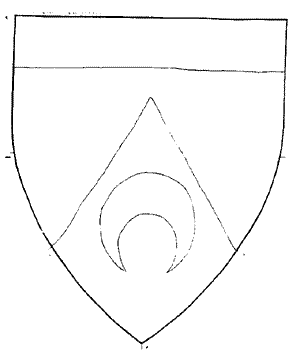 |
Per chevron purpure and argent, a crescent pendant purpure and a chief argent. The submitter desires a feminine name and will accept any changes. She will accept a holding name. Sibyl is cited from Talan Gwynek, Feminine Given Names in A Dictionary of English Surnames found at http://www.s-gabriel.org/names/talan/reaney/reaney.cgi?sibyl, and showing this spelling dated to 1201. Bossinney is cited from http://www.s-gabriel.org/names/badger/placenames.html as a placename dated 1227. The title of this article was not included with the copy showing the name and date information. |
|
| 21. Tadhg Fairbairn | Wyewood | Name and Device, New |
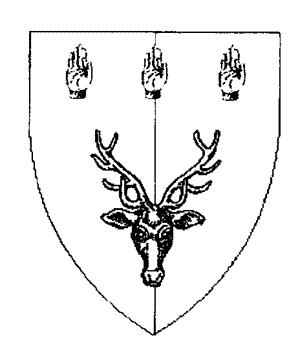 |
Per pale sable and vert, a stag's head cabossed argent attired Or, in chief three sinister hands couped apaumy argent. The submitter desires a male name, and is not specific about other considerations. He will accept any changes to the name, and will accept a holding name. Tadhg is cited from Acadamy of Saint Gabriel reports 1335 and 1308 as being from the 16th century or "late period" respectively. The reports cite Ó Corráin and Maguire's Irish Names and state that Tadhg is the later spelling of Tadc. Fairbairn is cited as a header spelling on pg. 161 of Reaney and Wilson, A Dictionary of English Surnames. An email quoting Elisabeth Pomegranate is included stating that "Robert Fayrebarne is found in 1297, and the name is also dated to 1379." |
|
| 22. Teffan Grenelefe | Glymm Mere | Name and Device, New |
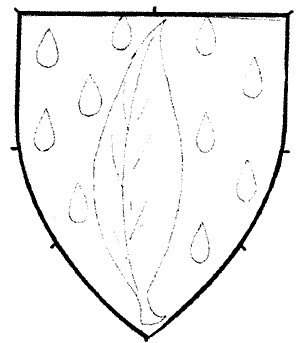 |
Argent, semi of gouttes purpure a beech leaf vert. The submitter will accept all changes, desires a feminine name with no other requests, and will accept a holding name. Teffan is cited from Reaney and Wilson, A Dictionary of English Surnames, sub Tiffany, Teffan is dated to 1379 in the Yorkshire Poll Tax Roll. Grenelefe is cited from Reaney and Wilson, A Dictionary of English Surnames, sub Greenleaf. Grenelefe is dated to 1441. |
|
| 23. Thomas Sinclair | Dragon's Mist | Household Name and Badge, New House of Hunter |
 |
Sable, a stag trippant between a chief engrailed and a point pointed argent. The submitter's primary SCA name was registered in September of 2001. The submitter will not accept any changes to the hiousehold name. They intend for the name to be authentic to the 1300 time period. House is documented from RfS III.2.b., "House of the White Hart", and in Reaney and Wilson, A Dictionary of English Surnames, under the header spelling House. The word is documented in this spelling, and was used as a surname in 1279. Hunter is documented from Reaney and Wilson, A Dictionary of English Surnames also, as a header spelling. Juliana LaHunter is dated 1312. This follows the construction examples found in RfS III.2.b. "House of Anjou". |
|
| 24. Þorlákr bjarki Eiriksson | Cáe Mór | Name and Device, New |
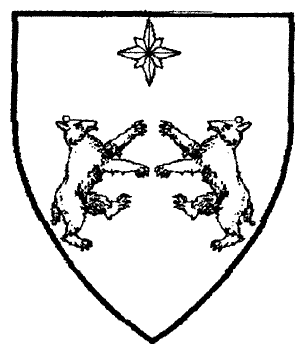 |
Azure, two bears combattant, in chief a compass star argent. The submitter will accept any changes and desire a masculine name and are not specific about time period or culture. He will accept a holding name. Þorlákr is cited from "Viking names found in the Landnamabok" by Aryanhwy merch Catmael at http://www.sit.wic.edu/~sfriedemann/names/landnamabok.htm. bjarki is cited as meaning 'bear cub' as found in "Viking Bynames found in the Landnamabok" by Aryanhwy merch Catmael, online at http://www.sit.wic.edu/~sfriedemann/names/vikbynames.htm. Eirikr is also cited from "Viking names found in the Landnamabok." The submitter cites the generation of Eiriksson from "A Simple Guide to Creating Old Norse Names", also by Aryanhwy merch Catmael, online at http://www.sit.wic.edu/~sfriedemann/names/sg-viking.htm. The construction guidelines show that masculine names ending in -r drop that consonant and replace it with -sson to form a masculine patronymic. Copies of all sites are included. |
|
| 25. Tir Righ, Principality of | c/o Principality Herald | Device, New |
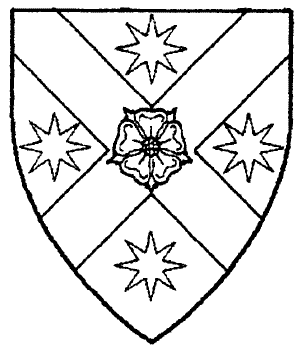 |
Azure, on a saltire between four mullets of eight points argent, a rose proper. The Principality's name was registered November 2002. This is intended to be arms for the Consort. A poll of the Principality populace was included with this submission, validated by the Principality Seneschal and showing a vote of 131 for, 11 against. All Principality officers were for the proposed arms. The forms are signed by their Highnesses Tir Righ. |
|
| 26. Tir Righ, Principality of | c/o Principality Herald | Badge, New |
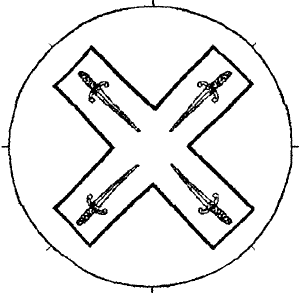 |
On a saltorel argent, four daggers points to center sable. The Principality's name was registered November 2002. This badge is intended to be for the Guardians of Tir Righ. The forms are signed by their Highnesses Tir Righ. The badge is fieldless. |
|
| 27. Tir Righ, Principality of | c/o Principality Herald | Order Name, New L'ordre de l'Etoile Argente |
|
The Principality's name was registered November 2002. The submitter accepts any changes. The documentation cites "Project Ordensnamen OR What do you mean the Ancient and Venerable Order of the Most Holy and Righteous Wombat's Toenail isn't period?" by Meradudd Cethin at http://sca.org/heraldry/laurel/names/order for the construction pattern of Color+Thing, exampled in Le Cordon Bleu, Golden Apple, and Gold Escutcheon. They also cite "A Collection of Period Order Names" by Lord Frederic Badger, http://www.nwlink.com/~badger/sca/ordnames.html, for the example Gold Estutcheon from France in 1369. The forms are signed by their Highnesses Tir Righ. |
||
| 28. Tir Righ, Principality of | c/o Principality Herald | Order Name, New Red Flame, Order of the |
|
The Principality's name was registered November 2002. They accept any changes. The documentation cites "Project Ordensnamen" for the construction pattern of Color+Thing, exampled in Le Cordon Bleu, Golden Apple, and Gold Escutcheon. The forms are signed by their Highnesses Tir Righ. |
||
| 29. Tir Righ, Principality of | c/o Principality Herald | Order Name, New Shattered Spear, Award of the |
|
The Principality's name was registered November 2002. They accept any changes. They cite "Project Ordensnamen" for the construction pattern of Adjective+Thing, exampled by Holy Phial, Precious Blood, and Pontifical Medal. They also cite "A Collection of Period Order Names" by Lord Frederic Badger, at http://www.nwlink.com/~badger/sca/ordnames.html, for the example The Defeated Dragon from Germany and dated 1418. The forms are signed by their Highnesses Tir Righ. |
||
| 30. Tir Righ, Principality of | c/o Principality Herald | Order Name and Badge, New Silver Pillar, Order of the |
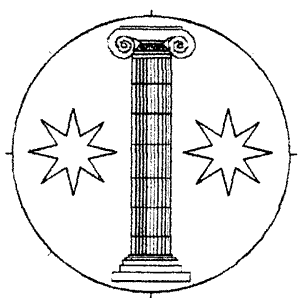 |
Azure, an Ionic Pillar between two mullets of eight points argent. The Principality's name was registered November 2002. They will accept any changes. The documentation cites "Project Ordensnamen" for the construction pattern of Color+Thing, exampled in Le Cordon Bleu, Golden Apple, and Gold Escutcheon. They also cite "A Collection of Period Order Names" for the example Gold Estutcheon from France in 1369. The forms are signed by their Highnesses Tir Righ. |
|
| 31. Tir Righ, Principality of | c/o Principality Herald | Heraldic Title, New Silver Yale Herald |
|
The Principality's name was registered November 2002. They will accept any changes. For documentation they cite RfS III.2.b.iii and also excerpt from "Heralds in History in the Middle Ages and Renaissance" by Leslie A. Schweitzer (writing as Dame Zenobia Naphtali, O.L., O.P.) http://www.antirheralds.org/symposium/heralds_history.html: " In England, most Heralds take the titles from the names of the original Lords. Most pursuivants take their title from Royal badges or badges of Royal orders ..." " In general, we find these patterns of sources for heralds titles as well as heraldic charges..." The forms are signed by their Highnesses Tir Righ. |
||
| 32. Tomyris Al Altani | Montengarde | Name, Change and Device, New change from Bébhinn Morgan |
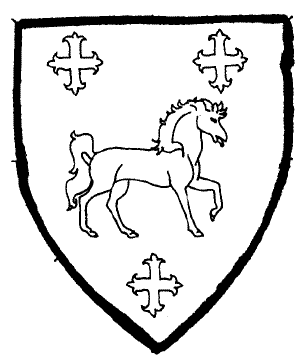 |
Vert, a horse passant contourny three crosses flory Or. Her current name was registered in May of 1993. The submitter accepts changes, and desires a feminine Yueh-Chi/Hun name. Her current name is to be released upon registration of this change. Tomyris is cited from Herodotus, The Histories, http:www.perseus.tufts.edu/cgi-bin/ptext?lookup=Hdt.+1.205.1. "Now at this time the Massagetae were ruled by a queen called Tomyris, whose husband was dead..." Her citations do not include copies of this source. Al Altani is cited from http://www.laohats.com, "Names from The Secret History of the Mongols", formed from the examples of Al Alta and Altani. A copy of this page is included. The lingual mix is documented from Otto J. Maenchen-Helfen, The World of the Huns; pg 383 states, 'Sometimes a man is known under two names, belonging to two different tongues. Or he has a name compounded of elements of two languages.' Copies of this source are included. |
|
| 33. Valgard Forkbeard | Vatnsdalr | Badge, Resubmission |
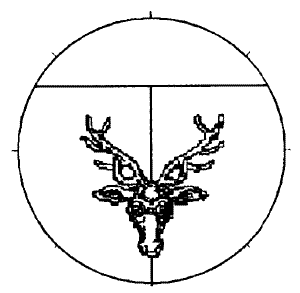 |
Per pale vert and azure, a stag's head cabossed and a chief argent. The submitter's name was sent to Laurel on the December 2003 IL. His previous badge, Per pale vert and azure a stags head cabossed argent, was returned in December 2003 for conflict with Aengus mac Coll - January 1981 (via Atenveldt), Vert, a stag's head cabossed argent, orbed and attired of flames proper, resting on its head a chalice Or, with only one CD for changes to the field. As Aengus' armory generates much conflict, Laurel precedents exist stating specifically that it simply counts as an argent stag's head cabossed for purposes of conflict, with the details thereon being insufficient for difference. This design adds a charge to the field. |
|
| 34. Ysabeau Symon d'Anjou | Dragon's Mist | Name, Resubmission |
|
The submitter will not accept major changes to this name. The submitter wishes a female name authentic for late 15th-early 16th century French. Her previous name, Ysabeau d' Anjou was returned from Laurel in October of 2003. "The submitted name Ysabeau d'Anjou also conflicts with the historical Isabelle d'Anjou." Ysabeau is cited from "French Names from Paris, 1421, 1423, & 1438" by Aryanhwy merch Catmael, online at http://www.ellipsis.cx/~liana/names/paris1423.html. Ysabeau is found three times in the data. In "Given Names from Brittany, 1384-1600" by Heather Rose Jones at http://www.s-gabriel.org/names/tangwystyl/latebretom/ Ysabeau is dated to 1537. Symon is cited from "French Names from Paris, 1421, 1423, & 1438" where it appears as a masculine name, and from "An Index to the Given Names in the 1292 Census of Paris" by Lord Colm Dubh at http://www.sca.org/heraldry/laurel/names/paris.html. Anjou is cited from "French Names from Two Thirteenth Century Chronicles" by Arval Benicoeur at http://www.s-gabriel.org/names/arval/crusades/crusades.html (please note URL corrected from the printed version of this IL) from the list of places names used in locative surnames. This article also is the source for the double byname "...Of the four double bynames, one has a patronymic plus a standard locative..." |
||
In service,

Written by: |
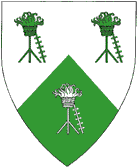
HTML by: |
